I remember talking with one of the UK’s leading advertising photographers perhaps 30 years ago about the problems of working with advertising directors, and how they would often present him with briefs that were quite impossible to shoot, requiring him to be pointing his camera in opposite derctions at the same time, combining views from very different places or those taken with and ultra-wide and a super-telephoto. Things which had been easy on the AD’s sketchpad were not always so simple in reality. Sometimes, thanks to the superb skills of London’s retouchers in those almost entirely pre-digital days, things could be achieved using multiple exposures, but often what really earned him his money was the long slow business of getting the AD to believe that what was achievable in camera was really what he had wanted after all.
It isn’t a problem I’ve ever had to deal with (though I have a few times been asked by editors for the impossible) but I do often find myself struggling over the tension between recording events in an accurate fashion and producing interesting pictures – although of course trying to combine the two.
I try to avoid the ‘newspaper cliches’ which often involve setting up an attractive person (or better still a ‘celebrity’) with an obvious prop – and of course will not set up such pictures, though I have sometimes taken advantage of them when set up by others – though with a caption that clearly indicates their nature and generally looking for a different view. At some protests where the organisers know me I’ve been asked for advice on what photographers would like, and have always been reluctant to give more than the most general of suggestions, perhaps about setting up something in the shade or with a particular building such as the Houses of Parliament in the background. I’m there as a journalist and not an organiser.
Protest organisers often come up with ideas that don’t seem to translate well or easily into images, and many pictures of protests reflect this. It’s seldom the organised picture opportunities that produce interesting images, though picture editors seem often to prefer these.
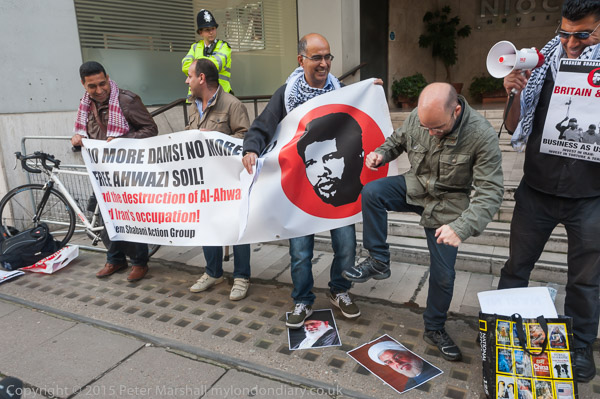
But sometimes a little action makes things spring to life, as when the Hashem Shabani Action Group began to stamp on photographs of Iran’s Supreme Leader Ayatollah Ali Khamenei, or a woman points her finger accusingly at the poster she is holding comparing the Islamic Republic as ‘Like ISIS, Only Bigger’.
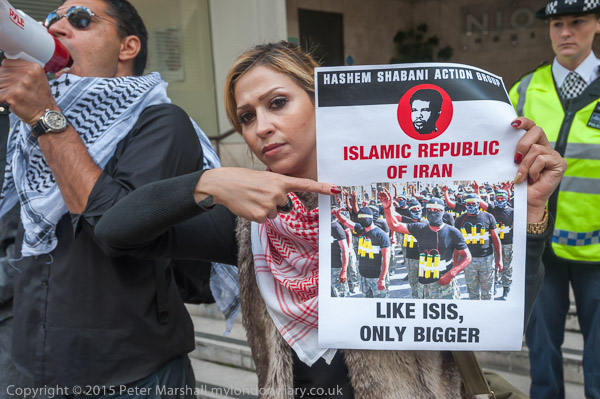
There were a few other little moments I caught at this protest that amused me, including one of a man rushing late to the AGM of the British Iranian Chamber of Commerce putting on his tie as he runs around the end of the protest.
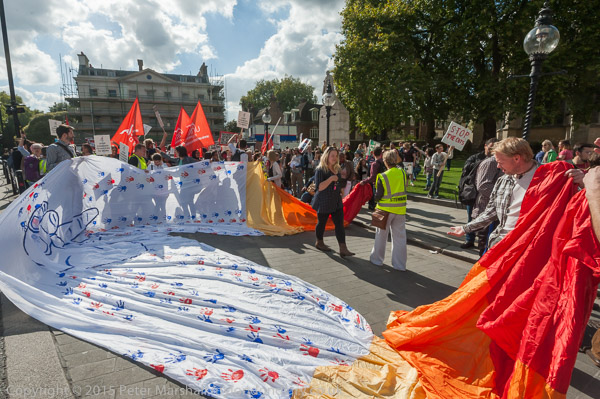
The huge banner covered with red and blue hand-prints carried horizontally by supporters of British Sign Language at the protest by deaf and disabled people and their supporters at the cutting of the DWP’s Access to Work scheme was also something of a challenge. I’d liked the way it showed the shadows of the people standing behind it and taken quite a few pictures as they got ready to march. Later I’d tried to catch it with Big Ben in the background as the marchers went down the side of Parliament Square, but wasn’t really happy until Big Ben was almost out of sight.
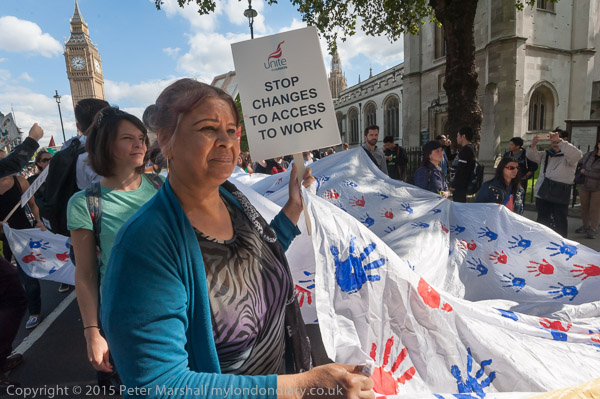
I left the Access to Work protesters to rush off to Grow Heathrow at Sipson, where the Harvest Festival celebrations included an open meeting on the expansion of Heathrow. Its only a few miles – across the airport – from where I live and something I’ve been involved with since birth. Long before that we had more sense, and in 1920 closed down London’s first commercial airport – on Hounslow Heath just a few yards from where my father used to live – because there area was too often subject to fogs, and Croydon became the site of London’s Airport. We managed to close that too in 1959, though meanwhile London Airport had come back almost to Hounslow with a huge airport across the orchards, farms and market gardens of Heathrow, using a wartime emergency requisition order to avoid any public inquiry – which might well have ruled against it.
By 1966 questions were being asked in Parliament calling for the closure of Heathrow, and several commissions and inquiries have been set up since, most recently the Davies commission, which cunningly sifted out the most suitable alternatives before going on to its final detailed considerations.
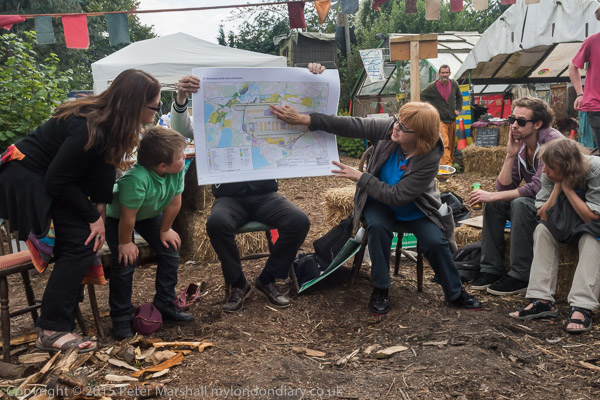
This was also a discussion in which I took part, asking several questions and making a few short contributions which perhaps went past journalistic objectivity. Discussions are seldom easy things to take lively images of, and I was quite pleased with what I managed to show both of that discussion and of Grow Heathrow, though I was disappointed not to have time to stay for the free six course vegan meal.